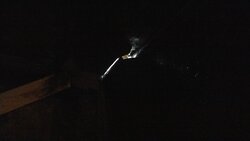Hello all,
I started to disassemble my stove (1983 Vigilant) because of issues with achieving a horizontal burn. I have approximately 20'+ of 8" chimney. The stove is air tight and passes the light test. I start my normal vertical burn and get the griddle 500-600ºF and chimney temps ~400ºF. Draft is more than satisfactory, I don't have a problem opening the top when in vertical burn. I close the damper with the keyhole airway fully open and almost immediately the temperatures start to drop until the chimney gets to be around 200ºF after about 10 minutes. It definitely seems like the stove is starving for air, because if I crack the griddle open during horizontal burn the wood springs back to life with flames.
At this point I can open the damper again, get the temperatures back up and repeat the process and once again the temperatures take a nose dive. My wood is hardwood, seasoned, and between 8-15% moisture. I'm generating way too much creosote burning at these low temperatures, so I decided to start ripping stuff apart to clean everything out and to make sure I don't have any blockages in the keyhole airway.
I removed the damper, upper and lower fireback, and noticed this large gap around the keyhole airway:

Should that circled gap be cemented closed? It seems to me that instead of air being sucked into the fire box most of it will be sucked right up the chimney with the draft. Here is a second picture with a flashlight shining directly into the keyhole:

Thank you for all your help, and I hope my issue is as simple as resealing some parts of the stove.
I started to disassemble my stove (1983 Vigilant) because of issues with achieving a horizontal burn. I have approximately 20'+ of 8" chimney. The stove is air tight and passes the light test. I start my normal vertical burn and get the griddle 500-600ºF and chimney temps ~400ºF. Draft is more than satisfactory, I don't have a problem opening the top when in vertical burn. I close the damper with the keyhole airway fully open and almost immediately the temperatures start to drop until the chimney gets to be around 200ºF after about 10 minutes. It definitely seems like the stove is starving for air, because if I crack the griddle open during horizontal burn the wood springs back to life with flames.
At this point I can open the damper again, get the temperatures back up and repeat the process and once again the temperatures take a nose dive. My wood is hardwood, seasoned, and between 8-15% moisture. I'm generating way too much creosote burning at these low temperatures, so I decided to start ripping stuff apart to clean everything out and to make sure I don't have any blockages in the keyhole airway.
I removed the damper, upper and lower fireback, and noticed this large gap around the keyhole airway:
Should that circled gap be cemented closed? It seems to me that instead of air being sucked into the fire box most of it will be sucked right up the chimney with the draft. Here is a second picture with a flashlight shining directly into the keyhole:
Thank you for all your help, and I hope my issue is as simple as resealing some parts of the stove.


